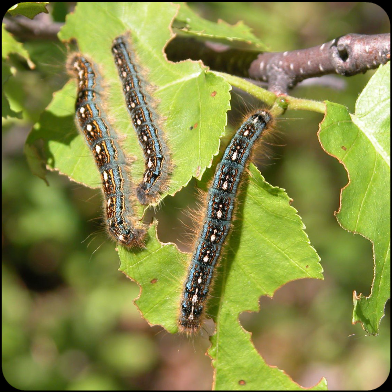THUNDER BAY — For many people, they are the creepiest critters of the summer.
Masses of forest tent caterpillars have emerged in some city neighbourhoods to do what forest tent caterpillars do – eat the leaves of various deciduous tree species including poplar, aspen, birch and apple.
Residents have posted photos of infestations on social media, prompting comments such as "So gross!"
Taylor Scarr, director of the integrated pest management division at the Great Lakes Forestry Centre in Sault Ste. Marie, travelled to Thunder Bay last week and said he noticed "a fair bit of forest tent caterpillar defoliation" on aspen stands in the area.
"It's not every stand that's affected, but some are very severely affected, with 100 per cent of the leaves being eaten already this spring."
The forest tent caterpillar is the most widespread defoliator of hardwood trees in North America, but healthy trees can recover and grow new leaves later in the summer.
"Although it's unsightly and the insect is a nuisance, it will collapse on its own and most trees survive," Scarr told TBnewswatch.
Periodic outbreaks may occur every seven to 10 years or so, and they typically last for several years in a particular area before the population crashes due to a virus, a parasite called the friendly fly, or starvation.
The last significant infestation in Northwestern Ontario collapsed in 2017.
Scarr said this is the start of a new cycle in the Northwest, and that he would expect to see more defoliation next year.
Thunder Bay-based entomologist Ken Deacon recalled one year when trees were stripped so bare "it looked like it was winter time, and it was the end of June or beginning of July."
Health Canada states that outbreaks don't happen on a precise schedule because they depend on several environmental and biological factors.
The forest tent caterpillar has one generation each year.
Larvae begin to emerge in the spring, after passing the winter fully-formed within the eggs.
Despite their name, the larvae do not construct tents, but spin silken mats on tree trunks or branches where they congregate when not feeding.
After about a six-week feeding period, they spin yellowish cocoons where they pupate prior to transforming to moths, then the females lay eggs on tree branches in July to begin a new cycle.
The tan-coloured moths are nocturnal and live for five to 10 days, during which they deposit eggs in grey, cylinder-shaped masses completely surrounding small twigs.
Health Canada offers some advice online for dealing with tent caterpillar infestations:
In the summer, look for tough, yellow-to-white cocoons on tree trunks, fences, debris, and sheltered areas. In the fall, look for shiny, dark brown or grey saddle-like cases which straddle or encase twigs of trees that are known to be susceptible to tent caterpillar infestations. Destroy egg cases and cocoons by scraping them off carefully (to avoid damage to the bark), and dispose of them in a sealed bag.
In the spring, if webs are present, colonies of young larvae can be removed by clipping and destroying the tents and caterpillars. This is best done when the caterpillars are at rest in the tent, either in early morning, late evening, or on cool rainy days. A pole pruner can be used to remove the nests in taller trees.
Biological Control
The bacterium B.t. (Bacillus thuringiensis) is a selective biological insecticide. After eating vegetation treated with B.t., caterpillar larvae will stop feeding and die within five days. Thorough coverage of foliage is needed, and spraying should not be done until the first signs of leaf damage appear. Younger larvae are more susceptible to this product.
Insects other than the larvae of moths and butterflies are not affected by B.t. made to be used against caterpillars. Products that contain this bacterium are also non-toxic to mammals, birds, and fish.
(Source: Health Canada)
